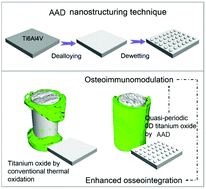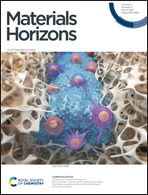Nanosurfacing Ti alloy by weak alkalinity-activated solid-state dewetting (AAD) and its biointerfacial enhancement effect†
Abstract
Nanoscale manipulation of material surfaces can create extraordinary properties, holding great potential for modulating the implant–bio interface for enhanced performance. In this study, a green, simple and biocompatible nanosurfacing approach based on weak alkalinity-activated solid-state dewetting (AAD) was for the first time developed to nano-manipulate the Ti6Al4V surface by atomic self-rearrangement. AAD treatment generated quasi-periodic titanium oxide nanopimples with high surface energy. The nanopimple-like nanostructures enhanced the osteogenic activity of osteoblasts, facilitated M2 polarization of macrophages, and modulated the cross-talk between osteoblasts and macrophages, which collectively led to significant strengthening of in vivo bone–implant interfacial bonding. In addition, the titanium oxide nanopimples strongly adhered to the Ti alloy, showing resistance to tribocorrosion damage. The results suggest strong nano–bio interfacial effects, which was not seen for the control Ti alloy processed through traditional thermal oxidation. Compared to other nanostructuring strategies, the AAD technique shows great potential to integrate high-performance, functionality, practicality and scalability for surface modification of medical implants.



 Please wait while we load your content...
Please wait while we load your content...